May 26, 2022
Your Guide to SEO Writing in 2022
The best way to drive people to your website or landing page is to create great content. Whether you write a blog or craft an infographic, the content should be relevant and attention-grabbing.
Once upon a time hitting those points in your content would have been enough. But not anymore. In this content-saturated digital age, your content faces huge competition to get seen and that’s where Search Engine Optimization (SEO) comes in.
Why is SEO important? Because it uses a set of techniques to increase the visibility of your content and web pages aimed at a specific audience you’re looking to target. Utilizing SEO ensures your content is relevant and findable by conducting keyword research and optimization, writing meta tags, optimizing headings, including internal links, and attracting quality backlinks.
Content marketing and SEO need to work together to drive traffic and engagement. The goal is to get your content in front of the right people and often that relies on where it’s positioned as a result of an online search - that means Google which is the market leader with an 85 percent market share.
In this blog, we’ll introduce you to SEO writing and reveal simple tips that will help you write SEO-optimized copy to drive traffic and leads.
What is SEO content writing?
SEO content writing is a way to create content that’s optimized on-page to help your content get a high ranking on search engines. It also signals that your content is relevant and of high quality.
When we talk about content, that can be anything that exists online you want your audience to find. This includes:
- Blog posts
- Landing pages
- Product pages
- Guides or eBooks
- Infographics
- Videos
- Toolkits
- Glossaries
Alongside keyword research and optimization, it’s important to ensure your content is organized. This means that your content should be in a logical order on your site and easy for visitors to locate. A great way to do this is to plan a flow for your content and include relevant links but a sitemap to help SEO and make your content findable.
There’s also no point in creating great content if you don’t share it! Make sure you have a plan to promote all your content on social media networks, link to relevant content in your emails, and get staff or brand advocates involved by asking them to share it on their networks. The wider you share your content, the more likely it is you will increase reach and drive backlinks.
If your content fails to land on the first SERP (Search Engine Results Page) you’ll see Clickthrough Rates (CTRs) nosedive to less than one percent. The difference between CTR in 1st position #1 on Google is significant compared to 2nd position #2 - 40 percent click vs. 18 percent. If your content fails to land on the first SERP (Search Engine Results Page) you’ll see CTRs nosedive to less than 1 percent.
Now that you know what SEO writing is, let's look at advice from DMI experts and some takeaway tips you can apply to your own work.
Writing for SEO: Top tips from technical writers
The practice of SEO is about the visibility of your content, but don’t forget to make sure that your content is tailored to your specific and unique audience.
It’s wise to keep on top of content and SEO marketing trends to stay ahead of your competition and spot any opportunities to get your content seen. We’ll take you through 9 key tips to help you write with SEO in mind.
1. Understand the KPI of your writing
Good SEO writing is not just about including a few keywords and being left at that.
This is where your content marketing KPIs play a role as they will help you determine the end goal of each piece of content. You should also have content in your marketing mix that drives people through the marketing funnel from awareness through to conversion.
“There is magic in SEO as it becomes this intersection of tech and story. You can tell a powerful story, sprinkle the magic of SEO on top of it, and not only do your readers see it, but more importantly, search engines see it, and you can move to the top of the rankings,” says Pamela Foley, Chief of Content Marketing & Strategy, AOU Creative.
For example, top of the funnel content for driving awareness includes blog posts, e-books, and infographics, while bottom of the funnel content to encourage conversions includes demos, testimonials or webinars.
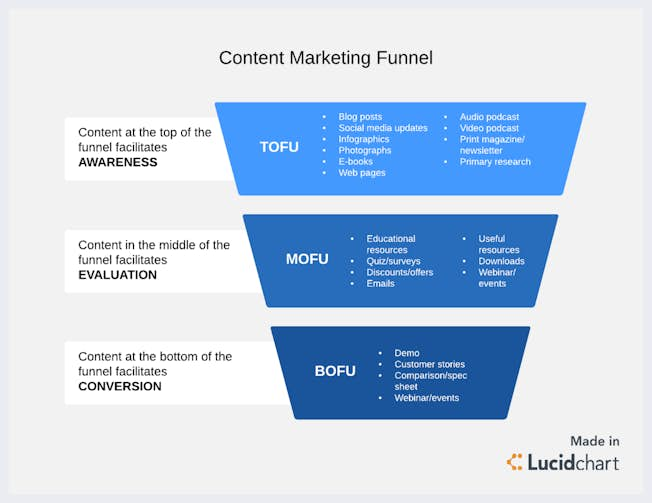
2. Create a structure based on a strategy
An important part of your overall strategy is creating an effective content marketing strategy. Without one it will be difficult to ensure that you are creating relevant content that drives prospects through the sales funnel and that what you create will appeal to your buyer personas.
There are several approaches to a strategy but one that works well for SEO is the ‘Hub and Spoke model’ (also known as the ‘Pillar and Clusters model’). This approach generates content around a broad topic as a hub piece and then generates supplementary content that links to it that goes into more detail - these are your spokes.
For example, let’s take SEO writing. A hub piece would be ‘What is SEO writing?’ and a spoke piece to link to and support it would be ‘SEO for Bloggers: How to Optimize Your Articles’.
This approach will not only help you build a lot of content (and show expertise) on a particular topic but help increase keyword rankings, drive traffic and grow KPIs such as leads and sales.
“The hub and spoke model is something we recommend our clients use as a structure in building out their content calendars. It’s effective because when search engines like Google crawl your website, it sees that you’re writing interconnected and relevant content on a subject. The more you write about something, especially if you’re plugging content gaps or providing original information, it rewards you by increasing your rankings on searches, also increasing your brand awareness, clicks, and more.” - Nicai de Guzman, Content Team Lead for Wolfgang Digital.
3. Find SEO keywords by using keyword research tools
A crucial element of SEO writing is keywords. There are five essential steps to keyword research:
- Define
- Brainstorm
- Filter
- Inspect
- Prioritize
Once you have a target list, you can use research tools to help rank and explore keywords. There are free tools like AlsoAsked and AnswerThePublic, but the searches are limited on a free account so you won’t get huge volumes unless you pay.
Paid tools such as Semrush and AHREFS are very useful and give you a full account of keyword volume, competitive insights, etc.
4. Make sure your headers are in order
Blogs are an important part of a company’s content marketing strategy. They allow you to draw people in through relevant and engaging content that can be used to increase dwell time and encourage click-through.
But today’s users are digitally savvy and want information quickly which is why blog headers are so important. When people read longer pieces of content they tend to scan or skim. That means they are looking for information that’s important to them.
To give a flow to your blog, improve accessibility and highlight what each section is about, use headers throughout. H1s should be the most important followed by H2s and H3s.
If you need help with starting a blog check out our 5 simple steps or to create and format a blog, use our handy blog template.
5. Write using the tone suited to your industry
Every industry is different and the messaging and tone that works for one doesn’t necessarily work for another.
For example, a consumer beauty brand may use imagery and adopt a tone that’s upbeat and friendly, while a B2B software provider may need to use a more formal and factual approach. When it comes to tone, think about the one you use carefully as one that’s risqué may turn your customers off rather than engage.
You should also keep your community in mind and be inclusive so that when a user visits your website or social media feed, they can see what you are about.
You may already know what tone works for your prospects and customers. But if you don’t it’s crucial to understand your ‘ideal’ customer. This requires creating buyer personas for your audience segment so you know how to attract and engage them.
Get started today by using our buyer persona template to make the most of your content.
“Experiment with your content to find a tone that resonates with your audience. Use social media to try different things such as bringing in humor or talking about a social issue your brand cares about. You could be surprised at the results,” says Emma Prunty, DMI Editor.
6. Include relevant internal and external links
Links are the best way to guide website visitors to other relevant content. To get the most from your content, include internal links that will drive people to content of interest - think of the ‘Hub and Spoke model’. You can also drive people to the ‘money pages’ that give them the opportunity to purchase.
External links or backlinks are an important part of SEO as they will link to your content from third-party sites. The more external sites that link to your content the better as it will drive search rankings and show value in your content.
If you have third-party links as part of your strategy, make sure you focus on backlinks of high-quality rather than a lot of low-quality ones that will have little impact on your SEO.
“It's important to have links, particularly internal links so that people stay on your website longer as you're linking to other articles and pages on your website. High-quality backlinking is not a bad thing as well, as long as you’re actually going to high-quality websites and sharing your information,” comments Foley from AOU Creative.
7. Suit your writing based on the platform and output
Any content marketer will tell you that each platform requires its own content. What that means is that the way you write for a blog will not work for a social media post or landing page.
Each content type and platform requires its own approach and style. If you’re writing a blog, you’re taking people on a journey and creating a story. Whereas a Google ad needs to hit all the relevant keywords and be compelling to encourage a click within seconds.
8. Write compelling CTAs
If you’ve put a lot into creating a piece of content, make sure you give people the opportunity to take an action. The aim of a CTA is to convert a reader or visitor into a lead that can be nurtured.
There are several types of CTAs you can use:
- Sign-up or Subscribe - Use this to encourage people to sign up to a newsletter or updates
- Learn more - This invites people to go to a tailored landing page or another section of the site. It can also act as a teaser for launch events as used by Apple in this email invite.
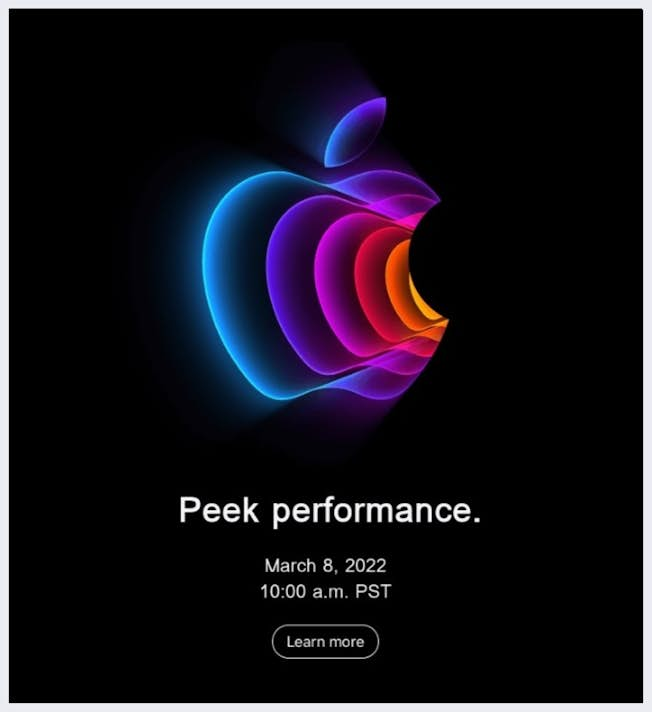
- Get started - This can encourage people to sign up for a course or start on a learning journey
- Download now - You can use this to urge users to download an eBook or whitepaper
- Donate or Get involved - This is used by the non-profit sector to raise awareness of a campaign or drive donations. Airbnb recently got involved to help house Ukrainian refugees by asking people to ‘Host a refugee’.
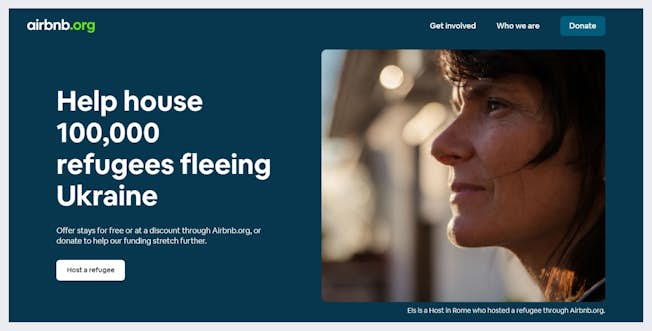
- Get my discount - This can prompt people to sign up to a mailing list to get a discount code
- Try for free - This is for a free trial or demo. We use this example on our site to invite people to try a free digital skills test
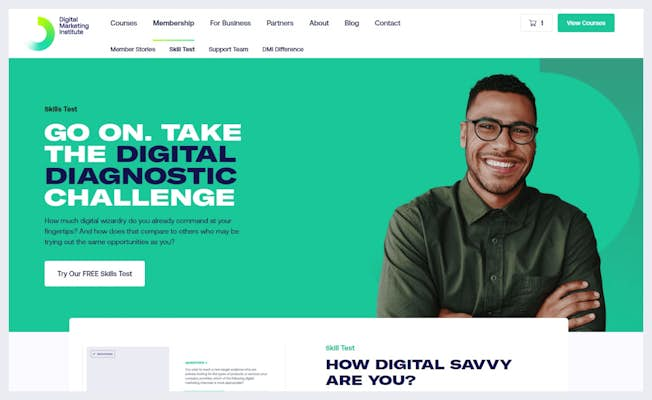
9. Always optimize!
You may think that once you hit ‘publish’, your job is done. Unfortunately, that’s not the case when it comes to content.
There’s always room for improvement, even for your top-performing blogs or landing pages. Information can get old especially if you’re using statistics or including third-party reports. Keywords also go in and out of style, so the ones you identified for a campaign six months ago may no longer be searched for at all now.
So you always need to optimize your content. The best way to do this is to perform an audit of your on-site SEO, particularly for key pages that drive leads or revenue. You also should keep an eye on how content is performing and if you see a slide in views or leads, try to identify why. You can do this by looking at your data and picking out content that’s seen a decrease over some time.
At DMI, we worked with Wolfgang Digital to optimize our blogs using SEO tactics. This involved including relevant keywords, refreshing content and including internal links to refresh top-performing content. As a result, in just one quarter we saw a 143 percent growth in leads from the blog year on year.
“The most important part of any SEO content strategy is to leverage as much low-hanging fruit as possible. Before creating tons of new content, we knew it was important to identify posts which had the potential to rank higher for their existing search terms while gathering visibility for more long-tail terms through optimizing the content that competed more strongly with existing top-ranking pages. Through the power of internal linking, we capitalized on DMI’s existing content to create an ‘ecosystem’ in which one page strengthens the other by spreading link equity more efficiently,” Lorna Franklin, Client Lead, Wolfgang Digital.
Watch our webinar on how to create content that’s guaranteed to engage your audience for some tips on authenticity and content creation.
What is an SEO writing example?
Now that you know the tactics required to optimize your content using SEO, here are some great examples you can take inspiration from.
SEO writing for blogs
You may be already making SEO mistakes on your blog and not even know it. If you use SEO content writing for your blogs they can benefit in terms of search engine rankings.
Here’s a recent blog we wrote about YouTube with SEO in mind. The headline ‘How to Create a YouTube Channel’ focuses on keywords ‘how to’ and ‘YouTube channel’ which will show Google and other search engines exactly what the article is focused on.
The opening paragraph also includes a link that directs people to another relevant YouTube article on our blog followed by a reputable third-party link in the second paragraph.
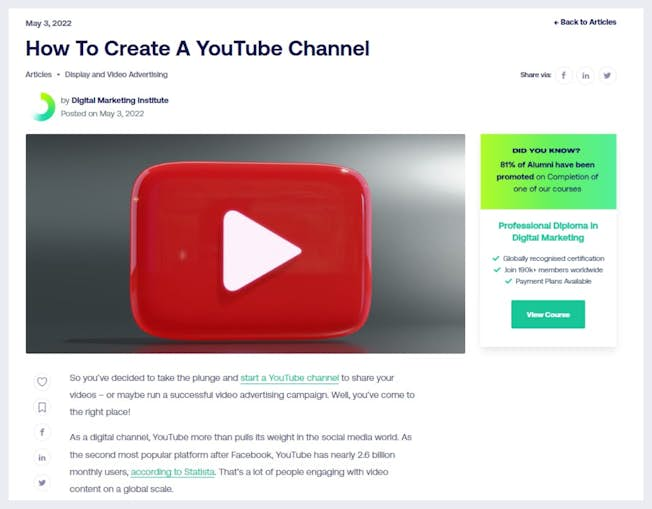
The blog goes on to outline key ways to create a channel with relevant images and bullets to space out the content with internal and external links throughout.
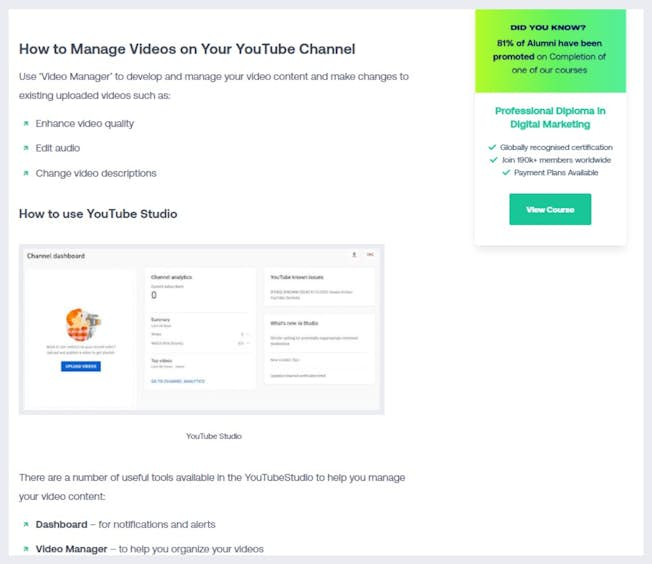
The end of the blog features a CTA that directs people to a relevant DMI course to help create a YouTube channel followed by an image CTA to ‘View Courses’.
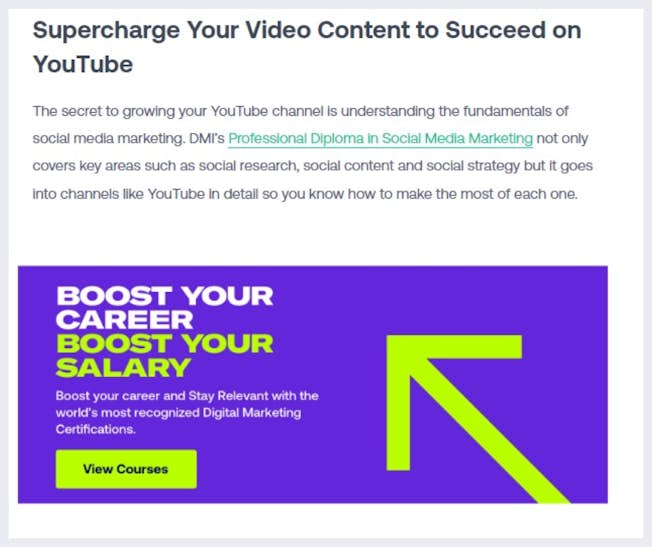
SEO writing for landing pages
Landing pages are key to driving conversions. So the content you include on them needs to be relevant and SEO optimized with a clear CTA.
Intercom - B2B
Software company Intercom creates great landing pages that stick to their brand’s look and feel and keep their content to a minimum. However, what they include is very clear and it’s easy to see what they are offering a visitor.
The white background makes the imagery stand out with a positive headline using the words ‘build’, ‘life’ and ‘engagement’. Their CTAs are clear, offering ‘Get started’ or ‘Free Demo’. Clicking on either CTA drives a user to a sign-up page for email capture.

‘Get Started’ CTA
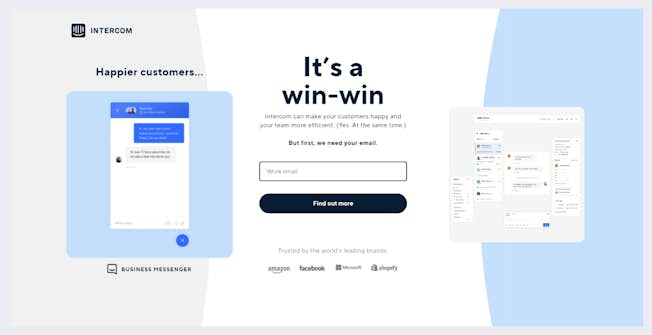
Gucci - B2C
Digital fashion brand Gucci epitomizes luxury and creates landing pages that ooze style. The infamous GG logo takes over the background in a simple yet eye-popping palette. In the example below, content is kept to a minimum but plays to the image ‘The GG in Blue’ as it relates to the blue cake.
Navigation is made easy through the top menu and the CTA is simple - ‘SHOP THE COLLECTION’ encouraging either a click or scroll.
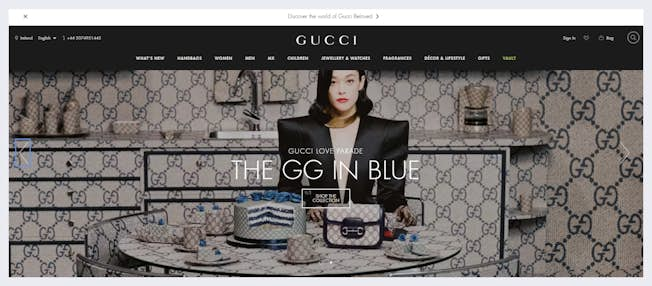
The Digital Marketing Institute - B2C
This page is designed to promote the new Professional Diploma in Search Marketing Course and uses optimized copy to include relevant keywords such as ‘SEO’, ‘PPC’ and ‘Google AdWords’ (and thousands of other terms we hold in our online dictionary).
The content also informs visitors of the type of course and price, and the page displays the logos of our Global Industry Advisory Council to show our broader industry accreditation. The CTA is simple but stands out against the white background: ‘Download Brochure’.
Shopify - B2B
Ecommerce giant Shopify creates landing pages to encourage brands to sell their products and services through their platform. The headline tells you what you need to know as a visitor ‘Everything you need to sell anywhere’.
The body text is impactful and uses keywords that demonstrate global reach and the ease of using Shopify such as ‘trust’, ‘sell’, ‘ship’, and ‘process’. There’s also a CTA at the top of the page and the bottom of the panel to take the same action ‘Start free trial’.

“SEO is a slower and more organic way of people finding you that takes hard work and time. But if you do it well, you'll reap the rewards. So if you've got a product that's not something that you can buy from thousands of other places such as a custom BBQ, then SEO is gonna be more helpful to you than if you sell white socks, where thousands of shops sell it,” James Williamson, Managing Director from digital marketing agency, 8th Dial.
SEO writing for product pages
There’s an art to writing a good product page for ecommerce as there are a lot of elements to include to drive a visitor to purchase (look at these 12 SEO tips for ecommerce for even better engagement). Here are some top examples.
Birchbox - B2C
Beauty subscription service Birchbox has a range of products organized into boxes it sends out monthly. The aim is to give people the opportunity to try a range of products that are personalized to their skin or hair type etc.
The product page showcases the products, includes customer reviews, and has a section below the second panel that tells visitors how to use it. The copy is simple and filled with keywords such as ‘glow’, ‘illuminate’, and ‘summer’. The headline links the product to the upcoming summer season and deems it ‘essential’ while the CTA is simply ‘Add to Basket’.
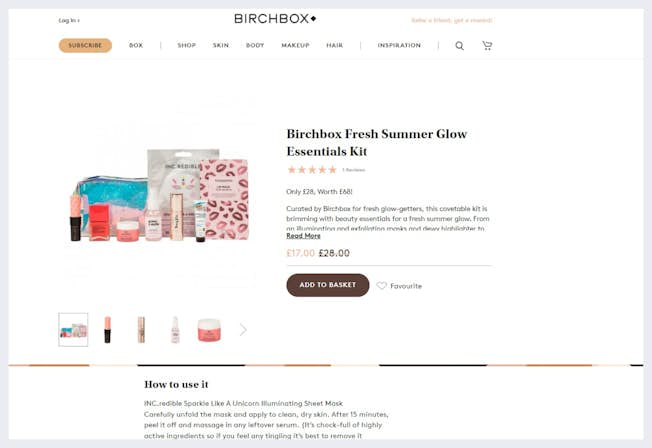
Peloton - B2C
Cycling brand Peloton has a high price point for its bikes but uses copy on its product pages sparsely and effectively.
The headline ‘Transform your workout with game-changing cardio’ taps into the desire to get fit and be transformed. It tackles the high price point by offering monthly payments and 0% financing. It also offers a 30-day home trial and cost comparison function. The CTA is simple - ‘Shop Bike’!

Good Health - B2C
With a focus on healthy foods in recent years (just look at the success of alternative products like oat drink company, Oatly), Good Health launched an organic range of crisps. The product page uses copy wisely but gets the message across about the snacks being healthy and gluten-free.
The imagery is eye-catching and the content outlines the products using keywords such as ‘baked’, ‘real cheese’, and ‘organic’ with trademarks included. The three CTAs offer customers choices for online purchasing or in-store ordering.
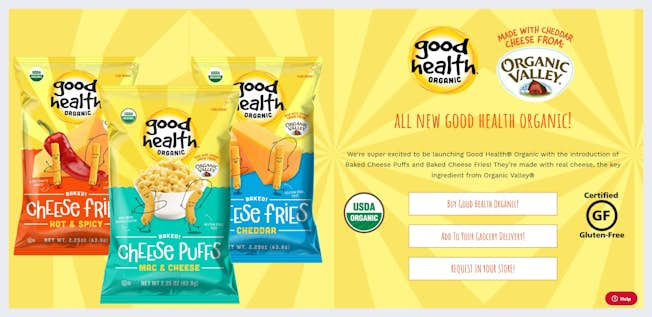
If you scroll down, the page breaks into panels that describe each product in more detail. It uses keywords such as ‘love’, ‘kids’, and favorite.
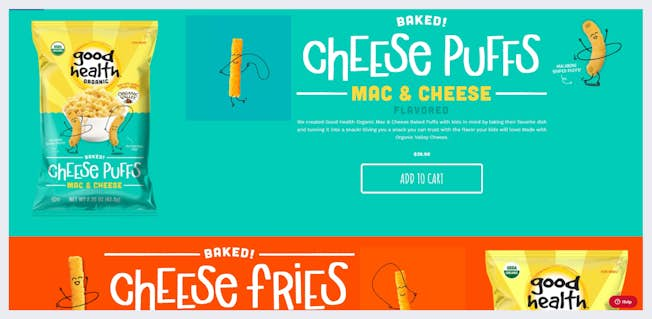
“SEO is incredibly powerful because people, when they search on search engines, especially if they use conversion keywords, are ready to purchase. It's not like they've seen an ad float by on Instagram or read their mum's post on Facebook and something pops up, they are actively looking for what you do. They just don't know that you do it,” Kate Toon, Copywriter Extraordinaire.
Is SEO writing a good career?
Research by Lucidpress found that 85 percent of professionals saw the demand for content increase during 2021 and that personalized content can boost a brand’s revenue by 48 percent.
That just demonstrates the need for content marketers across industries. But to become a successful content marketer, you need to have an awareness of SEO. After all, companies want to be found online and creating relevant, SEO-optimized content is one of the most effective ways to do that.
But is SEO writing easy? In a nutshell, it takes practice! With organic search being the primary source for a website, applying SEO practices to your content will help increase online visibility among the people that count - your prospects and customers.
Concentrate on the key areas that will make a difference to your SEO writing - keywords, headings, meta tags, CTAs, internal links, and backlinks. Local SEO also becomes important for personalization and for businesses such as a restaurant or cafe that focus on a particular location.
“There’s no secret to SEO, it's very linear and black and white. Once you know how it works, you know. I think people are put off SEO because they think it's some kind of secret potion that only certain people can learn. Which is absolutely not true,” says SEO and content expert Kate Toon.
How much do SEO writers make?
Content marketing can be a lucrative career and offers the opportunity to become a freelancer or earn a living as a digital nomad. In 2022, what would be the average take-home pay of full-time and part-time SEO writers?
According to Comparably, the annual salary for an SEO content writer in the U.S ranges from $29,000 to $109,000, and in the United Kingdom, Talent.com states that an average salary is £25,500. Payscale puts the average salary for a content writer with SEO skills at nearly $46,000 while in Australia the average annual salary is nearly AU$57,000.
The rate varies when it comes to charging per word. Search Engine Journal surveyed SEO pros and found that rates varied from $0.02 to $2 per word.
The key is to gain experience in SEO writing that you can stand behind and use to negotiate your rates as a freelancer or in an interview for a role.
What makes a good SEO writer?
A good SEO writer can be hard to find which means they are in high demand. Primarily being able to write clear and engaging content is essential. To integrate SEO into writing you must have:
- Good research skills
- Keyword research and integration skills
- A working understanding of both industry and technical SEO
- Editing and proofreading experience
- Great organizational skills
- An eye for detail
Become an in-demand SEO writer
Expand your skillset and advance your career with DMI’s Professional Diploma in Search Marketing. This industry-aligned course will help you understand SEO content, paid search, strategy and planning, analytics, and much more. Get started today to boost your earning potential.
Related
Upgrade to Power Membership to continue
your access to thousands of articles, toolkits, podcasts, lessons and much much more.
Become a Power Member- Login
- View Courses
- - - -
- Courses
- Resources
- - - -
- My Account
- Change Password
- Logout





